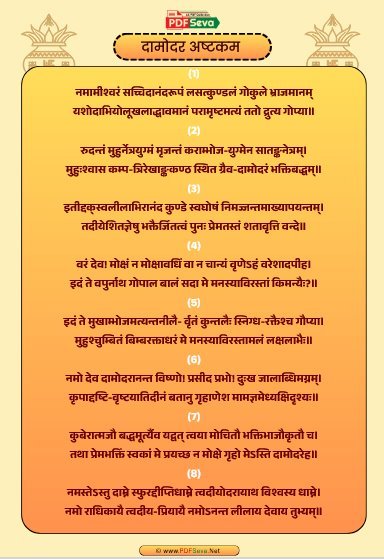About Damodar Ashtakam
The Damodar Ashtakam is a sacred and well-known prayer dedicated to Lord Shri Krishna, who is lovingly called Damodar. This prayer is especially significant during the holy month of Kartik (also known as Damodar Maas) and is chanted daily by devotees around the world, especially followers of ISKCON (International Society for Krishna Consciousness).
Composed by Satyavrata Muni, the Damodar Ashtakam is part of the Padma Purana. It glorifies the divine pastime where Mother Yashoda lovingly bound Lord Krishna with a rope around His belly — hence the name Damodar (from Dama = rope, Udar = belly).
Meaning of ‘Damodar’
The name Damodar is one of the twelve divine names of Lord Vishnu. It originates from the charming childhood pastime of Lord Krishna in Vrindavan, where He was tied by His mother, Mata Yashoda, with a rope to a wooden grinding mortar (Ukhal). This act symbolizes the deep love between the Lord and His devotee, and how divine love can even bind the Supreme.
Story Behind Damodar Ashtakam
According to Śrīmad Bhāgavatam (Canto 10):
Once, Mother Yashoda was busy churning curd while singing sweet songs about the playful deeds of Bal Krishna. Little Krishna, desiring her attention, came and stopped her churning rod. She lovingly took Him in her lap, but soon noticed that milk boiling on the stove was overflowing. She quickly put Krishna down and ran to save the milk.
Feeling neglected, Krishna became angry. In His childlike mischief, He broke the curd pot and went to another room to eat butter with the monkeys. When Yashoda returned and saw the mess, she realized her little boy was behind it. She quietly approached and caught Him red-handed. Seeing His mother with a stick, Krishna ran away in fear — but the loving mother chased and finally caught Him. Out of affection, she decided to tie Him to a wooden mortar so He wouldn’t make more mischief.
But each time she tried to tie the rope, it was two inches too short! Finally, by the Lord’s will, she succeeded — showing that pure love can bind even the Supreme Lord.
Significance of Damodar Ashtakam in ISKCON
In ISKCON temples worldwide, the Damodar Ashtakam is sung every evening during the Kartik month while offering ghee lamps (deep daan) to Lord Damodar. Devotees believe that offering a lamp and reciting this prayer during Kartik brings immense spiritual blessings and divine love from Shri Krishna.
Chanting Damodar Ashtakam
- Occasion: Daily during the month of Kartik (October–November)
- Language: Sanskrit with Hindi/English meaning
- Recommended Practice: Offer a ghee lamp while singing
- Duration: 8 verses (Ashtakam = eight stanzas)
Conclusion
The Damodar Ashtakam is not just a prayer — it is a beautiful expression of bhakti (devotion), love, and surrender. It reminds us that God is not conquered by strength or wealth, but by the simplicity of pure, selfless love.
दामोदर अष्टकम – Damodar Ashtakam lyrics
नमामीश्वरं सच्-चिद्-आनन्द-रूपं
लसत्-कुण्डलं गोकुले भ्राजमनम्
यशोदा-भियोलूखलाद् धावमानं
परामृष्टम् अत्यन्ततो द्रुत्य गोप्या ॥ १॥
रुदन्तं मुहुर् नेत्र-युग्मं मृजन्तम्
कराम्भोज-युग्मेन सातङ्क-नेत्रम्
मुहुः श्वास-कम्प-त्रिरेखाङ्क-कण्ठ
स्थित-ग्रैवं दामोदरं भक्ति-बद्धम् ॥ २॥
इतीदृक् स्व-लीलाभिर् आनन्द-कुण्डे
स्व-घोषं निमज्जन्तम् आख्यापयन्तम्
तदीयेषित-ज्ञेषु भक्तैर् जितत्वं
पुनः प्रेमतस् तं शतावृत्ति वन्दे ॥ ३॥
वरं देव मोक्षं न मोक्षावधिं वा
न चन्यं वृणे ‘हं वरेषाद् अपीह
इदं ते वपुर् नाथ गोपाल-बालं
सदा मे मनस्य् आविरास्तां किम् अन्यैः ॥ ४॥
इदं ते मुखाम्भोजम् अत्यन्त-नीलैर्
वृतं कुन्तलैः स्निग्ध-रक्तैश् च गोप्या
मुहुश् चुम्बितं बिम्ब-रक्ताधरं मे
मनस्य् आविरास्ताम् अलं लक्ष-लाभैः ॥ ५॥
नमो देव दामोदरानन्त विष्णो
प्रसीद प्रभो दुःख-जालाब्धि-मग्नम्
कृपा-दृष्टि-वृष्ट्याति-दीनं बतानु
गृहाणेष माम् अज्ञम् एध्य् अक्षि-दृश्यः ॥ ६॥
कुवेरात्मजौ बद्ध-मूर्त्यैव यद्वत्
त्वया मोचितौ भक्ति-भाजौ कृतौ च
तथा प्रेम-भक्तिं स्वकां मे प्रयच्छ
न मोक्षे ग्रहो मे ‘स्ति दामोदरेह ॥ ७॥
नमस् ते ‘स्तु दाम्ने स्फुरद्-दीप्ति-धाम्ने
त्वदीयोदरायाथ विश्वस्य धाम्ने
नमो राधिकायै त्वदीय-प्रियायै
नमो ‘नन्त-लीलाय देवाय तुभ्यम् ॥ ८॥
नमामीश्वरं सच्चिदानंदरूपं
लसत्कुण्डलं गोकुले भ्राजमानं
यशोदाभियोलूखलाद्धावमानं
परामृष्टमत्यं ततो द्रुत्य गोप्या ॥ १॥
रुदन्तं मुहुर्नेत्रयुग्मं मृजन्तम्
कराम्भोज-युग्मेन सातङ्क-नेत्रम्
मुहुः श्वास-कम्प-त्रिरेखाङ्क-कण्ठ
स्थित-ग्रैवं दामोदरं भक्ति-बद्धम् ॥ २॥
इतीदृक् स्वलीलाभिरानंद कुण्डे
स्व-घोषं निमज्जन्तम् आख्यापयन्तम्
तदीयेशितज्ञेषु भक्तिर्जितत्वम
पुनः प्रेमतस्तं शतावृत्ति वन्दे ॥ ३॥
वरं देव! मोक्षं न मोक्षावधिं वा
न चान्यं वृणेऽहं वरेशादपीह
इदं ते वपुर्नाथ गोपाल बालं
सदा मे मनस्याविरास्तां किमन्यैः ॥ ४॥
इदं ते मुखाम्भोजम् अत्यन्त-नीलैः
वृतं कुन्तलैः स्निग्ध-रक्तैश्च गोप्या
मुहुश्चुम्बितं बिम्बरक्ताधरं मे
मनस्याविरास्तामलं लक्षलाभैः ॥ ५॥
नमो देव दामोदरानन्त विष्णो
प्रभो दुःख-जालाब्धि-मग्नम्
कृपा-दृष्टि-वृष्ट्याति-दीनं बतानु
गृहाणेष मामज्ञमेध्यक्षिदृश्यः ॥ ६॥
कुबेरात्मजौ बद्ध-मूर्त्यैव यद्वत्
त्वया मोचितौ भक्ति-भाजौ कृतौ च
तथा प्रेम-भक्तिं स्वकां मे प्रयच्छ
न मोक्षे ग्रहो मेऽस्ति दामोदरेह ॥ ७॥
नमस्तेऽस्तु दाम्ने स्फुरद्-दीप्ति-धाम्ने
त्वदीयोदरायाथ विश्वस्य धाम्ने
नमो राधिकायै त्वदीय-प्रियायै
नमोऽनन्त-लीलाय देवाय तुभ्यम् ॥ ८॥
Read More : Radha chalisa – राधा चालीसा हिंदी में
दामोदर अष्टकम – Damodar Ashtakam pdf
You can download the Damodar Ashtakam PDF from the link below.
The file includes:
- Hindi ( sanskrit ) Lyrics
- PDF File
- High Quality HD Images
- Meaning & Interpretation

